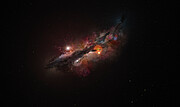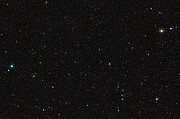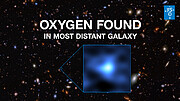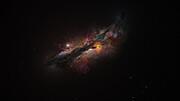在已知最遥远星系中发现 Oxygen
新闻稿
在已知最遥远星系中发现 Oxygen
2025年3月20日
两支不同的天文学家团队在已知最遥远的星系 JADES-GS-z14-0 中探测到了 Oxygen。 这项发现发表在两篇独立的论文中,这要归功于 Atacama Large Millimeter/submillimeter Array (ALMA),European Southern Observatory (ESO) 是其合作伙伴。 这一破纪录的探测让天文学家们重新思考早期宇宙中星系的形成速度。
去年被发现的 JADES-GS-z14-0 是迄今为止发现的最遥远的星系:它距离我们如此遥远,以至于它的光花费了 134 亿年才到达我们这里,这意味着我们看到的它是宇宙诞生不到 3 亿年时的样子,大约是现在年龄的 2%。 借助位于智利 Atacama 沙漠中的望远镜阵列 ALMA 进行的最新 Oxygen 探测表明,该星系的化学成熟度远超预期。
荷兰 Leiden Observatory 的博士研究生 Sander Schouws 说:“这就像发现了一个青少年,而你本以为只能找到婴儿”。他是荷兰主导的研究的第一作者,该研究已被《The Astrophysical Journal》接收发表。 “结果表明,该星系形成速度非常快,成熟速度也很快,这为星系的形成速度远快于预期的这一观点提供了越来越多的证据。”
星系通常在其生命之初充满了年轻恒星,这些恒星主要由氢和氦等轻元素组成。 随着恒星的演化,它们会产生像 Oxygen 这样的更重元素,并在它们死亡后分散到它们的宿主星系中。 研究人员曾认为,在 3 亿年前,宇宙还太年轻,无法形成富含重元素的星系。 然而,两项 ALMA 研究表明,JADES-GS-z14-0 拥有的重元素大约是预期的 10 倍。
意大利 Pisa 的 Scuola Normale Superiore 的 Stefano Carniani 说:“我对这些意想不到的结果感到震惊,因为它们为星系演化的最初阶段开辟了新的视野”。他是已被《Astronomy & Astrophysics》接收发表的论文的主要作者。 “一个星系在婴儿宇宙中已经成熟的证据引发了关于星系何时以及如何形成的问题。”
Oxygen 的探测也让天文学家们能够更准确地测量 JADES-GS-z14-0 的距离。“ALMA 的探测提供了对星系距离的极其精确的测量,精确到只有 0.005% 的不确定性。 这种精度水平——相当于在 1 公里的距离上精确到 5 厘米以内——有助于我们完善对遥远星系属性的理解,”Pisa 的 Scuola Normale Superiore 的博士生 Eleonora Parlanti 补充道,他是《Astronomy & Astrophysics》研究[1]的作者。
Leiden Observatory 团队成员、副教授 Rychard Bouwens 说:“虽然该星系最初是由James Webb Space Telescope发现的,但它需要 ALMA 来确认并精确确定其巨大距离”,[2]。 “这表明 ALMA 和 JWST 之间存在惊人的协同作用,可以揭示第一批星系的形成和演化。”
European ALMA Regional Centre 的 ESO 天文学家 Gergö Popping 没有参与这些研究,他说:“我对 JADES-GS-z14-0 中如此清晰的 Oxygen 探测感到非常惊讶。 这表明,在大爆炸之后,星系的形成速度可能比之前认为的要快。 这一结果展示了 ALMA 在揭示我们宇宙中第一批星系形成条件方面所发挥的重要作用。”
注释
[1] 天文学家使用一种称为红移的测量方法来确定到极其遥远物体的距离。 先前的测量表明,星系 JADES-GS-z-14-0 的红移在 14.12 到 14.4 之间。 凭借他们的 Oxygen 探测,两个团队现在都将范围缩小到 14.18 左右的红移。
[2] James Webb Space Telescope 是 NASA、European Space Agency (ESA) 和 Canadian Space Agency (CSA) 的联合项目。
更多信息
这项研究发表在即将发表在《Astronomy & Astrophysics》(__https://aanda.org/10.1051/0004-6361/202452451) 和《The Astrophysical Journal》上的两篇论文中。
团队成员包括: 意大利领导的《Astronomy & Astrophysics》论文:Stefano Carniani (Scuola Normale Superiore, Pisa, Italy [SNS])、Francesco D’Eugenio (Kavli Institute for Cosmology, University of Cambridge, Cambridge, UK [CAM-KIC]; Cavendish Laboratory, University of Cambridge, Cambridge, UK [CAM-CavL] and INAF – Osservatorio Astronomico di Brera, Milano, Italy)、Xihan Ji (CAM-KIC and CAM-CavL)、Eleonora Parlanti (SNS)、Jan Scholtz (CAM-KIC and CAM-CavL)、Fengwu Sun (Center for Astrophysics | Harvard & Smithsonian, Cambridge, USA [CfA])、Giacomo Venturi (SNS)、Tom J. L. C. Bakx (Department of Space, Earth, & Environment, Chalmers University of Technology, Gothenburg, Sweden)、Mirko Curti (European Southern Observatory, Garching bei München, Germany)、Roberto Maiolino (CAM-KIC, CAM-CavL and Department of Physics and Astronomy, University College London, London, UK [UCL])、Sandro Tacchella (CAM-KIC and CAM-CavL)、Jorge A. Zavala (National Astronomical Observatory of Japan, Tokyo, Japan)、Kevin Hainline (Steward Observatory, University of Arizona, Tucson, USA [UArizona-SO])、Joris Witstok (Cosmic Dawn Center, Copenhagen, Denmark [DAWN] and CAM-CavL)、Benjamin D. Johnson [CfA]、Stacey Alberts [UArizona-SO]、Andrew J. Bunker (Department of Physics, University of Oxford, Oxford, UK [Oxford])、Stéphane Charlot (Sorbonne Université, CNRS, Institut d’Astrophysique de Paris, Paris, France)、Daniel J. Eisenstein (CfA)、Jakob M. Helton (UArizona-SO)、Peter Jakobsen (DAWN and Niels Bohr Institute, University of Copenhagen, Copenhagen, Denmark)、Nimisha Kumari (Space Telescope Science Institute, Baltimore, USA)、Brant Robertson (Department of Astronomy and Astrophysics University of California, Santa Cruz, USA)、Aayush Saxena (Oxford and UCL)、Hannah Übler (CAM-KIC and CAM-CavL)、Christina C. Williams (NSF NOIRLab, Tucson, USA)、Christopher N. A. Willmer (UArizona-SO) 和 Chris Willott (NRC Herzberg, Victoria, Canada)。
荷兰领导的《The Astrophysical Journal》论文:Sander Schouws (Leiden Observatory, Leiden University, Leiden, the Netherlands [Leiden])、Rychard J. Bouwens (Leiden)、Katherine Ormerod (Astrophysics Research Institute, Liverpool John Moores University, Liverpool, United Kingdom [LJMU])、Renske Smit (LJMU)、Hiddo Algera (Hiroshima Astrophysical Science Center, Hiroshima University, Hiroshima, Japan and National Astronomical Observatory of Japan, Tokyo, Japan)、Laura Sommovigo (Center for Computational Astrophysics, Flatiron Institute, New York, USA)、Jacqueline Hodge (Leiden)、Andrea Ferrara (Scuola Normale Superiore, Pisa, Italy)、Pascal A. Oesch (Département d’Astronomie, Université de Genève, Versoix, Switzerland; Cosmic Dawn Center, Copenhagen, Denmark and Niels Bohr Institute, University of Copenhagen, Copenhagen, Denmark)、Lucie E. Rowland (Leiden)、Ivana van Leeuwen (Leiden)、Mauro Stefanon (Leiden)、Thomas Herard-Demanche (Leiden)、Yoshinobu Fudamoto (Center for Frontier Science, Chiba University, Chiba, Japan)、Huub Rottgering (Leiden) 和 Paul van der Werf (Leiden)。
Atacama Large Millimeter/submillimeter Array (ALMA) 是一座国际天文设施,是 ESO、美国 National Science Foundation (NSF) 和日本 National Institutes of Natural Sciences (NINS) 之间合作的伙伴关系,并与智利共和国合作。 ALMA 的资金由 ESO 代表其成员国提供,NSF 与加拿大 National Research Council (NRC) 和台湾 National Science and Technology Council (NSTC) 合作提供,NINS 与台湾 Academia Sinica (AS) 和韩国 Korea Astronomy and Space Science Institute (KASI) 合作提供。 ALMA 的建造和运营由 ESO 代表其成员国领导; 由 Associated Universities, Inc. (AUI) 管理的 National Radio Astronomy Observatory (NRAO) 代表北美领导; 由 National Astronomical Observatory of Japan (NAOJ) 代表东亚领导。 Joint ALMA Observatory (JAO) 提供对 ALMA 建设、调试和运营的统一领导和管理。
European Southern Observatory (ESO) 使世界各地的科学家能够发现宇宙的秘密,从而造福所有人。 我们设计、建造和运营世界一流的地面天文台——天文学家使用这些天文台来解决令人兴奋的问题并传播对天文学的迷恋——并促进天文学方面的国际合作。 ESO 于 1962 年作为一个政府间组织成立,如今 ESO 得到了 16 个成员国(奥地利、比利时、捷克、丹麦、法国、芬兰、德国、爱尔兰、意大利、荷兰、波兰、葡萄牙、西班牙、瑞典、瑞士和英国)以及智利主办国和澳大利亚作为战略合作伙伴的支持。 ESO 的总部及其游客中心和天文馆 ESO Supernova 位于德国慕尼黑附近,而智利的 Atacama 沙漠,一个拥有独特条件来观测天空的绝妙地方,拥有我们的望远镜。 ESO 运营着三个观测点:La Silla、Paranal 和 Chajnantor。 在 Paranal,ESO 运营着 Very Large Telescope 及其 Very Large Telescope Interferometer,以及 VISTA 等巡天望远镜。 同样在 Paranal,ESO 将主办并运营 Cherenkov Telescope Array South,这是世界上最大、最灵敏的伽马射线天文台。 与国际合作伙伴一起,ESO 在 Chajnantor 运营 ALMA,这是一个在毫米和亚毫米范围内观测天空的设施。 在 Paranal 附近的 Cerro Armazones,我们正在建造“世界上最大的天空之眼”——ESO 的 Extremely Large Telescope。 从我们在智利圣地亚哥的办事处,我们支持我们在该国的运营并与智利合作伙伴和社会互动。
链接
- 研究论文 (Carniani et al.)
- 研究论文 (Schouws et al.)
- ALMA 照片
- 对于记者:订阅以接收以您的语言发布的禁运发布,并申请参加 ESO 的(部分资助的)2025 年战略媒体访问(新)
- 对于科学家:有一个故事? 推销您的研究
- 新的 ESO 分析证实了 Paranal 附近计划的工业园区造成的严重破坏
联系方式
Stefano Carniani Scuola Normale Superiore Pisa, Italy 电话:+39 050 509156 邮箱:stefano.carniani@sns.it
Sander Schouws Leiden University Leiden, The Netherlands 邮箱:sanderschouws@gmail.com
Eleonora Parlanti Scuola Normale Superiore Pisa, Italy 邮箱:eleonora.parlanti@sns.it
Rychard Bouwens Leiden Observatory, University of Leiden Leiden, The Netherlands 电话:+31 71 527 8456 邮箱:bouwens@strw.leidenuniv.nl
Jacqueline Hodge Leiden Observatory, University of Leiden Leiden, The Netherlands 电话:+31 71 527 8450 邮箱:hodge@strw.leidenuniv.nl
Gergö Popping European ALMA Regional Centre, European Southern Observatory 电话:+49 89 3200 6247 邮箱:gpopping@eso.org
Bárbara Ferreira ESO Media Manager Garching bei München, Germany 电话:+49 89 3200 6670 手机:+49 151 241 664 00 邮箱:press@eso.org
在社交媒体上与 ESO 联系 ESO 图像、视频、网络文本和音乐的使用 您是记者吗? 以您的语言订阅 ESO 媒体通讯。
关于此版本
发布编号:| eso2507 ---|--- 名称:| JADES-GS-z14-0 类型:| 早期宇宙:星系 设施:| Atacama Large Millimeter/submillimeter Array
图片
 PR Image eso2507a
早期宇宙中最遥远的 Oxygen 探测
PR Image eso2507a
早期宇宙中最遥远的 Oxygen 探测
 PR Image eso2507b
已知最遥远星系中的 Oxygen 光谱
PR Image eso2507b
已知最遥远星系中的 Oxygen 光谱
 PR Image eso2507c
JADES-GS-z14-0 的艺术家印象
PR Image eso2507c
JADES-GS-z14-0 的艺术家印象
 PR Image eso2507d
JADES-GS-z14-0 周围天空区域的广域视图
PR Image eso2507d
JADES-GS-z14-0 周围天空区域的广域视图
视频
 PR Video eso2507a
在最遥远星系中发现 Oxygen
PR Video eso2507a
在最遥远星系中发现 Oxygen
 PR Video eso2507b
Oxygen 何时首次诞生
PR Video eso2507b
Oxygen 何时首次诞生
 PR Video eso2507c
放大 JADES-GS-z14-0
PR Video eso2507c
放大 JADES-GS-z14-0
向我们发送您的评论! 订阅以接收以您的语言发布的 ESO 新闻 由 CDN77 加速 条款和条件 Cookie 设置和政策
我们对 Cookie 的使用
我们使用对于访问我们的网站和使用我们的服务至关重要的 cookie。 我们还使用 cookie 来分析、衡量和改进我们网站的性能,以支持通过社交媒体共享内容以及显示托管在第三方平台上的媒体内容。 您可以阅读管理您的 cookie 首选项并通过访问“Cookie 设置和政策”了解更多信息。 接受所有 接受仅限必要 Cookie Cookie 设置和政策
ESO Cookie 政策
European Organisation for Astronomical Research in the Southern Hemisphere (ESO) 是天文学领域卓越的政府间科学和技术组织。 它实施了一项雄心勃勃的计划,重点在于设计、建造和运行用于天文观测的强大的地面观测设施。 本 Cookie 政策旨在通过概述 ESO 公共网站上使用的 cookie、其功能、您用于控制它们的选项以及您可以联系我们以获取更多详细信息的方式来提供清晰度。
什么是 Cookie?
Cookie 是您访问的网站存储在您设备上的小数据。 它们用于各种目的,例如记住登录凭据和偏好,并增强您的浏览体验。
我们使用的 Cookie 的类别
基本 Cookie(始终处于活动状态):这些 cookie 对于我们网站的正常运行是绝对必要的。 没有这些 cookie,网站将无法正常运行,并且某些服务(例如登录或访问安全区域)可能不可用; 因为它们对于网站的运行至关重要,因此无法禁用它们。 Cookie ID/名称 描述/用途 提供商(第一方或第三方) 浏览器会话 Cookie 或存储的 Cookie? 持续时间 csrftoken XSRF 保护令牌。 我们使用此 cookie 来防止跨站点请求伪造攻击。 第一方 已存储 1年 user_privacy 您的隐私选择。 我们使用此 cookie 来保存您的隐私首选项。 第一方 已存储 6个月 _grecaptcha 我们使用 reCAPTCHA 来保护我们的表格免受垃圾邮件和滥用的侵害。 reCAPTCHA 在执行时会设置一个必要的 cookie,以便提供其风险分析。 我们使用 www.recaptcha.net 而不是 www.google.com,以避免来自 Google 的不必要的 cookie。 第三方 已存储 6个月 功能性 Cookie:这些 cookie 通过启用其他功能和个性化(例如记住您的偏好和设置)来增强您的浏览体验。 虽然对于网站运行不是绝对必要的,但它们提高了可用性和便利性; 只有在您提供同意后才会放置这些 cookie。 Cookie ID/名称 描述/用途 提供商(第一方或第三方) 浏览器会话 Cookie 或存储的 Cookie? 持续时间 设置 preferred_language 语言设置。 我们使用此 cookie 来记住您的首选语言设置。 第一方 已存储 1年 开启 | 关闭 sessionid ESO 商店。 我们使用此 cookie 来存储您在 ESO 商店中的会话信息。 这只是一个标识符,在服务器上使用,以便您可以在我们的商店中购买商品。 第一方 已存储 2周 开启 | 关闭 分析 Cookie:这些 cookie 收集有关访问者如何与我们的网站交互的信息,例如哪些页面访问频率最高以及用户如何浏览网站。 这些数据可帮助我们改进网站性能、优化内容并增强用户体验; 只有在您提供同意后才会放置这些 cookie。 我们使用以下分析 Cookie。 Matomo Cookie: 本网站使用 Matomo(以前称为 Piwik),这是一种开源软件,可对网站访问进行统计分析。 Matomo 使用 Cookie(文本文件),这些 Cookie 保存在您的计算机上,使我们能够分析您如何使用我们的网站。 Cookie 生成的网站用户信息仅保存在我们 IT 部门的服务器上。 我们使用此信息来分析 www.eso.org 访问并准备网站活动报告。 这些数据不会透露给第三方。 代表 ESO,Matomo 将使用这些信息来评估您对网站的使用情况、编制网站活动报告以及提供与网站活动和互联网使用相关的其他服务。 开启 | 关闭 Matomo Cookie 设置: Cookie ID/名称 描述/用途 提供商(第一方或第三方) 浏览器会话 Cookie 或存储的 Cookie? 持续时间 设置 _pk_id 存储唯一的访问者 ID。 第一方 已存储 13个月 _pk_ses 会话 Cookie 暂时存储访问的数据。 第一方 已存储 30分钟 _pk_ref 存储归因信息(将访问者带到网站的引荐来源)。 第一方 已存储 6个月 _pk_testcookie 临时 Cookie,用于检查访问者的浏览器是否支持 Cookie(仅在 Internet Explorer 中设置)。 第一方 已存储 临时 Cookie,几乎在设置后立即过期。 ESO 网站上的其他第三方 Cookie:我们的一些页面显示来自外部提供商的内容,例如 YouTube。 此类第三方服务不受 ESO 控制,并且可能随时更改其服务条款、Cookie 使用等。 YouTube:ESO 网站上的一些视频嵌入自 ESO 的官方 YouTube 频道。 我们已启用 YouTube 的隐私增强模式,这意味着除非用户主动单击视频进行播放,否则不会设置任何 Cookie。 此外,在此模式下,YouTube 不会存储任何用于嵌入式视频播放的可识别个人身份的 Cookie 数据。 有关更多详细信息,请参阅 YouTube 的嵌入视频信息页面。 Cookie 还可以根据以下元素进行分类。 关于域,有:
- 第一方 Cookie,由您当前访问的网站设置。 它们由您正在浏览的同一域存储,并用于增强您在该网站上的体验;
- 第三方 Cookie,由与您当前访问的域不同的域设置。
至于它们的持续时间,Cookie 可以是:
- 浏览器会话 Cookie,当用户关闭浏览器时会被删除;
- 存储的 Cookie,在用户的设备上保留一段预定的时间。
如何管理 Cookie
Cookie 设置:您可以随时通过单击任何页面底部的链接“Cookie 设置”来修改您对 ESO 网页的 Cookie 选择。 在您的浏览器中:如果您希望删除 Cookie 或指示您的浏览器默认删除或阻止 Cookie,请访问浏览器的帮助页面:
请注意,如果您删除或拒绝 Cookie,我们网站的某些功能可能不可用,并且您的浏览体验可能会受到影响。 您可以设置大多数浏览器来阻止任何 Cookie 放置在您的设备上,但您可能每次访问站点/页面时都必须手动调整某些首选项。 并且某些服务和功能可能根本无法正常工作(例如,个人资料登录、商店结帐)。
ESO Cookie 政策的更新
ESO Cookie 政策可能会受到未来的更新,这些更新将在此页面上提供。
补充信息
对于与 Cookie 相关的任何查询,请联系:pdprATesoDOTorg。 由于 ESO 公共网页由我们的通信部门管理,因此您的问题将在上述部门的支持下处理。
保存 取消 在 Facebook 上分享 [在 Twitter 上分享](https://twitter.com/intent/tweet?url=https://www.eso.org/public/news/eso2507/&text=Two different teams of astronomers have detected oxygen in the most distant known galaxy, JADES-GS-z14-0. The discovery, reported in two separate studies, was made possible thanks to the Atacama Large Millimeter/submillimeter Array (ALMA), in which the European Southern Observatory (ESO) is a partner. This record-breaking detection is making astronomers rethink how quickly galaxies formed in the early Universe.&via=ESO) [在 Pinterest 上分享](https://pinterest.com/pin/create/button/?url=https://www.eso.org/public/news/eso2507/&media=&description=Two different teams of astronomers have detected oxygen in the most distant known galaxy, JADES-GS-z14-0. The discovery, reported in two separate studies, was made possible thanks to the Atacama Large Millimeter/submillimeter Array (ALMA), in which the European Southern Observatory (ESO) is a partner. This record-breaking detection is making astronomers rethink how quickly galaxies formed in the early Universe.) 打印此页




